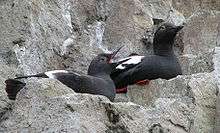List of birds of Canada

Canadian birds most closely resemble those of Eurasia, which was connected to the continent as part of the supercontinent Laurasia until around 60 million years ago.[1] Many groups occur throughout the Northern Hemisphere and worldwide. However some groups unique to the New World have also arisen; those represented in this list are the hummingbirds, the New World vultures, the New World quail, the tyrant flycatchers, the vireos, the mimids, the New World warblers, the tanagers, the cardinals and the icterids.
Several common birds in Canada, such as the house sparrow, the rock pigeon, the European starling, and the mute swan are introduced species, meaning that they are not native to this continent but were brought here by humans from Europe or elsewhere. Introduced species are marked on this list as (I). There may be species that have individual escapees or small feral populations in Canada that are not on this list. This is especially true of birds that are commonly held as pets, such as parrots and finches.
Taxonomy
The taxonomic treatment (designation and sequence of orders, families and species) and nomenclature (common and scientific names) used in the accompanying bird lists adhere to the conventions of the AOU's (1998) Check-list of North American Birds, the recognized scientific authority on the taxonomy and nomenclature of North America birds. The AOU's Committee on Classification and Nomenclature, the body responsible for maintaining and updating the Check-list, "strongly and unanimously continues to endorse the biological species concept (BSC), in which species are considered to be genetically cohesive groups of populations that are reproductively isolated from other such groups" (AOU 1998). See Sibley-Ahlquist taxonomy for an alternative phylogenetic arrangement based on DNA-DNA hybridization.
Unless otherwise noted, all species listed below are considered to occur regularly in North America as permanent residents, summer or winter residents or visitors, or migrants. The following codes are used to designate some species:
- (A) = accidental occurrence; based on one or two (rarely more) records, and unlikely to occur regularly
- (C) = casual occurrence; based on two or more records, with subsequent records not improbable
- (E) = Extinct; a recent species that no longer exists
- (Ex) = extirpated; no longer occurs in area of interest, but other populations still exist elsewhere
- (I) = introduced population; established solely as result of direct or indirect human intervention; synonymous with non-native and non-indigenous
This list follows the ABA for determination of rarity. The markings (A) and {C} correspond to the ABA birding codes five and four respectively.

Summary of 2006 IUCN Red List categories.
Conservation status - IUCN Red List of Threatened Species:
- EX - extinct, EW - extinct in the wild
- CR - critically endangered, EN - endangered, VU - vulnerable
- NT - near threatened, LC - least concern
- DD - data deficient, NE - not evaluated
- (v. 2013.2, the data is current as of March 5, 2014[2])
Ducks, geese and swans
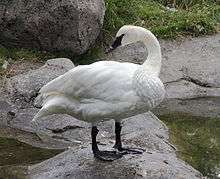
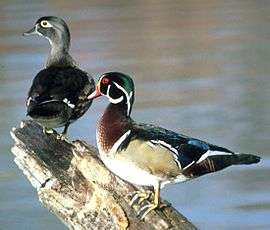
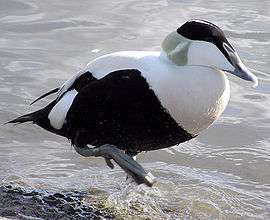
Order: Anseriformes Family: Anatidae
The family Anatidae includes the ducks and most duck-like waterfowl, such as geese and swans. These birds are adapted to an aquatic existence with webbed feet, bills which are flattened to a greater or lesser extent, and feathers that are excellent at shedding water due to special oils.
- Black-bellied whistling duck, Dendrocygna autumnalis LC
- Fulvous whistling duck, Dendrocygna bicolor LC
- Taiga bean goose, Anser fabalis LC (without A. serrirostris)
- Tundra bean goose, Anser serrirostris (A. fabalis: LC)
- Pink-footed goose, Anser brachyrhynchus (C) LC
- Greater white-fronted goose, Anser albifrons LC
- Emperor goose, Chen canagica NT
- Snow goose, Chen caerulescens LC
- Ross's goose, Chen rossii LC
- Cackling goose, Branta hutchinsii LC
- Canada goose, Branta canadensis LC
- Brant, Branta bernicla LC
- Barnacle goose, Branta leucopsis (C) LC
- Mute swan, Cygnus olor (I) LC
- Trumpeter swan, Cygnus buccinator LC
- Tundra swan, Cygnus columbianus LC
- Whooper swan, Cygnus cygnus LC
- Wood duck, Aix sponsa LC
- Gadwall, Anas strepera LC
- Falcated duck, Anas falcata (C) NT
- Eurasian wigeon, Anas penelope LC
- American wigeon, Anas americana LC
- American black duck, Anas rubripes LC
- Mallard, Anas platyrhynchos LC
- Blue-winged teal, Anas discors LC
- Northern shoveler, Anas clypeata LC
- Northern pintail, Anas acuta LC
- Garganey, Anas querquedula (C) LC
- Baikal teal, Anas formosa (C) LC
- Green-winged teal, Anas carolinensis (A. crecca: LC)
- Canvasback, Aythya valisineria LC
- Redhead, Aythya americana LC
- Ring-necked duck, Aythya collaris LC
- Tufted duck, Aythya fuligula LC
- Greater scaup, Aythya marila LC
- Lesser scaup, Aythya affinis LC
- Steller's eider, Polysticta stelleri VU
- Spectacled eider, Somateria fischeri LC
- King eider, Somateria spectabilis LC
- Common eider, Somateria mollissima LC
- Harlequin duck, Histrionicus histrionicus LC
- Labrador duck, Camptorhynchus labradorius (E) EX
- Surf scoter, Melanitta perspicillata LC
- White-winged scoter, Melanitta deglandi LC
- Black scoter, Melanitta americana NT
- Long-tailed duck, Clangula hyemalis VU
- Bufflehead, Bucephala albeola LC
- Common goldeneye, Bucephala clangula LC
- Barrow's goldeneye, Bucephala islandica LC
- Smew, Mergellus albellus LC
- Hooded merganser, Lophodytes cucullatus LC
- Common merganser, Mergus merganser LC
- Red-breasted merganser, Mergus serrator LC
- Ruddy duck, Oxyura jamaicensis }LC
Partridges, grouse, turkeys and Old World quail

Order: Galliformes Family: Phasianidae
Phasianidae consists of the pheasants and their allies. These are terrestrial species, variable in size but generally plump with broad relatively short wings. Many species are gamebirds or have been domesticated as a food source for humans.
- Chukar, Alectoris chukar (I) LC
- Grey partridge, Perdix perdix (I) LC
- Ring-necked pheasant, Phasianus colchicus (I) LC
- Ruffed grouse, Bonasa umbellus LC
- Greater sage-grouse, Centrocercus urophasianus NT
- Willow ptarmigan, Lagopus lagopus LC
- Rock ptarmigan, Lagopus muta LC
- White-tailed ptarmigan, Lagopus leucura LC
- Spruce grouse, Falcipennis canadensis LC
- Dusky grouse, Dendragapus obscurus LC
- Sooty grouse, Dendragapus fuliginosus LC
- Sharp-tailed grouse, Tympanuchus phasianellus LC
- Wild turkey, Meleagris gallopavo LC
New World quail

Order: Galliformes Family: Odontophoridae
The New World quails are small, plump terrestrial birds only distantly related to the quails of the Old World, but named for their similar appearance and habits.
- California quail, Callipepla californica LC
- Northern bobwhite, Colinus virginianus NT
Loons

Order: Gaviiformes Family: Gaviidae
Loons are aquatic birds the size of a large duck, to which they are unrelated. Their plumage is largely grey or black, and they have spear-shaped bills. Loons swim well and fly adequately, but, because their legs are placed towards the rear of the body, are almost helpless on land.
- Red-throated loon, Gavia stellata LC
- Yellow-billed loon, Gavia adamsii LC
- Pacific loon, Gavia pacifica LC
- Common loon, Gavia immer LC
Grebes
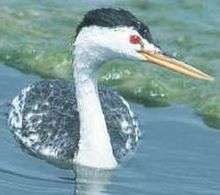
Order: Podicipediformes Family: Podicipedidae
Grebes are small to medium-large freshwater diving birds. They have lobed toes and are excellent swimmers and divers. However, they have their feet placed far back on the body, making them quite ungainly on land.
- Pied-billed grebe, Podilymbus podiceps LC
- Horned grebe, Podiceps auritus LC
- Red-necked grebe, Podiceps grisegena LC
- Eared grebe, Podiceps nigricollis LC
- Western grebe, Aechmophorus occidentalis LC
- Clark's grebe, Aechmophorus clarkii LC
Albatrosses
Order: Procellariiformes Family: Diomedeidae
The albatrosses are amongst the largest of flying birds, and the great albatrosses from the genus Diomedea have the largest wingspans of any extant birds.
- Atlantic yellow-nosed albatross, Thalassar chlororhynchus (A) EN
- Black-browed albatross, Thalassarche melanophris (A) NT
- Laysan albatross, Phoebastria immutabilis NT
- Black-footed albatross, Phoebastria nigripes NT
- Short-tailed albatross, Phoebastria albatrus VU
Shearwaters and petrels
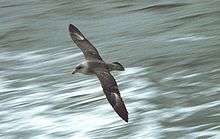
Order: Procellariiformes Family: Procellariidae
The procellariids are the main group of medium-sized "true petrels", characterized by united nostrils with medium septum and a long outer functional primary.
- Northern fulmar, Fulmarus glacialis LC
- Mottled petrel, Pterodroma inexpectata NT
- Bulwer's petrel, Bulweria bulwerii (A) LC
- Cory's shearwater, Calonectris diomedea LC
- Pink-footed shearwater, Ardenna creatopus VU
- Flesh-footed shearwater, Ardenna carneipes LC
- Great shearwater, Ardenna gravis LC
- Buller's shearwater, Ardenna bulleri VU
- Sooty shearwater, Ardenna griseus NT
- Short-tailed shearwater, Ardenna tenuirostris LC
- Manx shearwater, Puffinus puffinus LC
- Black-vented shearwater, Puffinus opisthomelas NT
- Audubon's shearwater, Puffinus lherminieri LC
Storm petrels

Order: Procellariiformes Family: Hydrobatidae
The storm petrels are the smallest seabirds, relatives of the petrels, feeding on planktonic crustaceans and small fish picked from the surface, typically while hovering. The flight is fluttering and sometimes bat-like.
- Wilson's storm petrel, Oceanites oceanicus LC
- Fork-tailed storm petrel, Oceanodroma furcata LC
- Leach's storm petrel, Oceanodroma leucorhoa LC
- Band-rumped storm petrel, Oceanodroma castro LC
- European storm petrel, Hydrobates pelagicus (A) LC
Tropicbirds
Order: Phaethontiformes Family: Phaethontidae
Tropicbirds are slender white birds of tropical oceans, with exceptionally long central tail feathers. Their long wings have black markings, as does the head.
- White-tailed tropicbird, Phaethon lepturus LC
Boobies and gannets
Order: Suliformes Family: Sulidae
The sulids comprise the gannets and boobies. Both groups are medium-large coastal seabirds that plunge-dive for fish.
- Brown booby, Sula leucogaster LC
- Northern gannet, Morus bassanus LC
Cormorants
Order: Suliformes Family: Phalacrocoracidae
Cormorants are medium-to-large aquatic birds, usually with mainly dark plumage and areas of coloured skin on the face. The bill is long, thin and sharply hooked. Their feet are four-toed and webbed.
- Brandt's cormorant, Phalacrocorax penicillatus LC
- Double-crested cormorant, Phalacrocorax auritus LC
- Great cormorant, Phalacrocorax carbo LC
- Red-faced cormorant, Phalacrocorax urile LC
- Pelagic cormorant, Phalacrocorax pelagicus LC
Darters
Order: Suliformes Family: Anhingidae
Darters are cormorant-like water birds with very long necks and long, straight beaks. They are fish eaters which often swim with only their neck above water.
- Anhinga, Anhinga anhinga LC
Frigatebirds
Order: Suliformes Family: Fregatidae
Frigatebirds are large seabirds usually found over tropical oceans. They are large, black or black-and-white birds, with long wings and deeply forked tails. The males have coloured inflatable throat pouches. They do not swim or walk and cannot take off from a flat surface. Having the largest wingspan-to-body-weight ratio of any bird, they are essentially aerial, able to stay aloft for more than a week.
- Magnificent frigatebird, Fregata magnificens LC
Pelicans
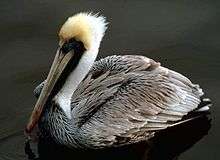
Order: Pelecaniformes Family: Pelecanidae
Pelicans are very large water birds with a distinctive pouch under their beak. Like other birds in the order Pelecaniformes, they have four webbed toes.
- Brown pelican, Pelecanus occidentalis LC
Bitterns, herons and egrets

Order: Pelecaniformes Family: Ardeidae
The family Ardeidae contains the herons, egrets and bitterns. Herons and egrets are medium to large wading birds with long necks and legs. Bitterns tend to be shorter necked and more secretive. Members of Ardeidae fly with their necks retracted, unlike other long-necked birds such as storks, ibises and spoonbills.
- American bittern, Botaurus lentiginosus LC
- Least bittern, Ixobrychus exilis LC
- Great blue heron, Ardea herodias LC
- Great egret, Ardea alba LC
- Little egret, egretta garzetta (C) LC
- Snowy egret, egretta thula LC
- Little blue heron, egretta caerulea LC
- Tricoloured heron, egretta tricolor LC
- Reddish egret, egretta rufescens NT
- Cattle egret, Bubulcus ibis LC
- Green heron, Butorides virescens LC
- Black-crowned night heron, Nycticorax nycticorax LC
- Yellow-crowned night heron, Nyctanassa violacea LC
Ibises and spoonbills
Order: Pelecaniformes Family: Threskiornithidae
Members of this family have long, broad wings, are strong fliers and, rather surprisingly, given their size and weight, very capable soarers. The body tends to be elongated, the neck more so, with rather long legs. The bill is also long, decurved in the case of the ibises, straight and distinctively flattened in the spoonbills.
- American white ibis, Eudocimus albus LC
- Glossy ibis, Plegadis falcinellus LC
- White-faced ibis, Plegadis chihi LC
New World vultures
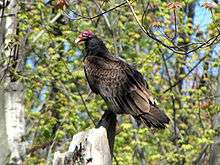
Order: Cathartiformes Family: Cathartidae
The New World vultures are not closely related to Old World vultures, but superficially resemble them because of convergent evolution. Like the Old World vultures, they are scavengers. However, unlike Old World vultures, which find carcasses by sight, New World vultures have a good sense of smell with which they locate carcasses.
- Black vulture, Coragyps atratus LC
- Turkey vulture, Cathartes aura LC
Osprey
Order: Accipitriformes Family: Pandionidae
Pandionidae is a family of fish-eating birds of prey, possessing a very large, powerful hooked beak for tearing flesh from their prey, strong legs, powerful talons and keen eyesight. The family is monotypic.
- Osprey, Pandion haliaetus LC
Eagles, kites and allies
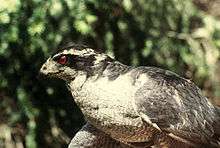
Order: Accipitriformes Family: Accipitridae
Accipitridae is a family of birds of prey, which includes hawks, eagles, kites, harriers and Old World vultures. These birds have very large powerful hooked beaks for tearing flesh from their prey, strong legs, powerful talons, and keen eyesight.
- Swallow-tailed kite, Elanoides forficatus LC
- White-tailed kite, Elanus leucurus LC
- Bald eagle, Haliaeetus leucocephalus LC
- White-tailed eagle, Haliaeetus albicilla (C) LC
- Northern harrier, Circus cyaneus LC
- Sharp-shinned hawk, Accipiter striatus LC
- Cooper's hawk, Accipiter cooperii LC
- Northern goshawk, Accipiter gentilis LC
- Red-shouldered hawk, Buteo lineatus LC
- Broad-winged hawk, Buteo platypterus LC
- Swainson's hawk, Buteo swainsoni LC
- Zone-tailed hawk, Buteo albonotatus LC
- Red-tailed hawk, Buteo jamaicensis LC
- Ferruginous hawk, Buteo regalis LC
- Rough-legged hawk, Buteo lagopus LC
- Golden eagle, Aquila chrysaetos LC
Falcons

Order: Falconiformes Family: Falconidae
Falconidae is a family of diurnal birds of prey, notably the falcons and caracaras. They differ from hawks, eagles and kites in that they kill with their beaks instead of their talons.
- Eurasian kestrel, Falco tinnunculus (C) LC
- American kestrel, Falco sparverius LC
- Merlin, Falco columbarius LC
- Gyrfalcon, Falco rusticolus LC
- Peregrine falcon, Falco peregrinus LC
- Prairie falcon, Falco mexicanus LC
Rails, gallinules and coots
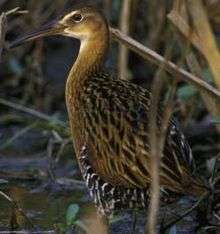
Order: Gruiformes Family: Rallidae
Rallidae is a large family of small to medium-sized birds which includes the rails, crakes, coots and gallinules. Typically, family members occupy dense vegetation in damp environments near lakes, swamps and rivers. In general they are shy and secretive birds, making them difficult to observe. Most species have strong legs and long toes which are well adapted to soft uneven surfaces. They tend to have short, rounded wings and to be weak flyers.
- Yellow rail, Coturnicops noveboracensis LC
- Black rail, Laterallus jamaicensis NT
- Corn crake, Crex crex (C) LC
- Clapper rail, Rallus crepitans LC
- King rail, Rallus elegans LC
- Virginia rail, Rallus limicola LC
- Sora, Porzana carolina LC
- Purple gallinule, Porphyrio martinicus LC
- Common gallinule, Gallinula galeata (G. chloropus: )
- Eurasian coot, Fulica atra (A) LC
- American coot, Fulica americana LC
Limpkin

Order: Gruiformes Family: Aramidae
The limpkin is an odd bird that looks like a large rail, but is skeletally closer to the cranes. It is found in marshes with some trees or scrub in the Caribbean, South America and southern Florida.
- Limpkin, Aramus guarauna LC
Cranes
Order: Gruiformes Family: Gruidae
Cranes are large, long-legged and long-necked birds. Unlike the similar-looking, but unrelated, herons, cranes fly with their necks outstretched, not pulled back. Most have elaborate and noisy courting displays.
- Sandhill crane, Grus canadensis LC
- Common crane, Grus grus (C) LC
- Whooping crane, Grus americana EN
Lapwings and plovers
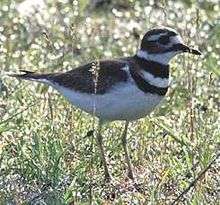
Order: Charadriiformes Family: Charadriidae
The family Charadriidae includes the plovers, dotterels and lapwings. They are small to medium-sized birds with compact bodies, short, thick necks and long, usually pointed, wings. They are found in open country worldwide, mostly in habitats near water.
- Northern lapwing, Vanellus vanellus (C) LC
- Black-bellied plover, Pluvialis squatarola LC
- European golden plover, Pluvialis apricaria (C) LC
- American golden plover, Pluvialis dominica LC
- Pacific golden plover, Pluvialis fulva LC
- Lesser sand plover, Charadrius mongolus (V) LC
- Greater sand plover, Charadrius leschenaultii (A) LC
- Collared plover, Charadrius collaris (A) LC
- Snowy plover, Charadrius nivosus (Ch. alexandrinus: LC)
- Wilson's plover, Charadrius wilsonia LC
- Common ringed plover, Charadrius hiaticula LC
- Semipalmated plover, Charadrius semipalmatus LC
- Piping plover, Charadrius melodus NT
- Killdeer, Charadrius vociferus LC
- Mountain plover, Charadrius montanus NT
Oystercatchers
Order: Charadriiformes Family: Haematopodidae
The oystercatchers are large, obvious and noisy plover-like birds, with strong bills used for smashing or prying open molluscs.
- Eurasian oystercatcher, Haematopus ostralegus (A) LC
- American oystercatcher, Haematopus palliatus LC
- Black oystercatcher, Haematopus bachmani LC
Stilts and avocets
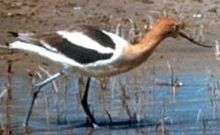
Order: Charadriiformes Family: Recurvirostridae
Recurvirostridae is a family of large wading birds, which includes the avocets and stilts. The avocets have long legs and long up-curved bills. The stilts have extremely long legs and long, thin, straight bills.
- Black-winged stilt, Himantopus himantopus (A) LC
- American avocet, Recurvirostra americana LC
Sandpipers and allies
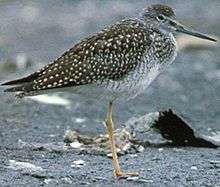
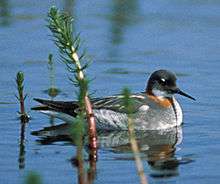
Order: Charadriiformes Family: Scolopacidae
Scolopacidae is a large, diverse family of small to medium-sized shorebirds including the sandpiper, curlew, godwit, shank, tattler, woodcock, snipe, dowitcher and phalarope. The majority of these species eat small invertebrates picked out of the mud or soil. Different lengths of legs and bills enable multiple species to feed in the same habitat, particularly on the coast, without directly competing for food.
- Common greenshank, Tringa nebularia LC
- Greater yellowlegs, Tringa melanoleuca LC
- Lesser yellowlegs, Tringa flavipes LC
- Common redshank, Tringa totanus (A) LC
- Spotted redshank, Tringa erythropus (C) LC
- Wood sandpiper, Tringa glareola LC
- Green sandpiper, Tringa ochropus (C) LC
- Solitary sandpiper, Tringa solitaria LC
- Willet, Tringa semipalmata LC
- Wandering tattler, Tringa incana LC
- Spotted sandpiper, Actitis macularius LC
- Terek sandpiper, Xenus cinereus LC
- Upland sandpiper, Bartramia longicauda LC
- Eskimo curlew, Numenius borealis (E?) CR
- Whimbrel, Numenius phaeopus LC
- Bristle-thighed curlew, Numenius tahitiensis VU
- Far Eastern curlew, Numenius madagascariensis (C) VU
- Slender-billed curlew, Numenius tenuirostris (E?) CR
- Eurasian curlew, Numenius arquata (C) NT
- Long-billed curlew, Numenius americanus LC
- Black-tailed godwit, Limosa limosa NT
- Hudsonian godwit, Limosa haemastica LC
- Bar-tailed godwit, Limosa lapponica LC
- Marbled godwit, Limosa fedoa LC
- Ruddy turnstone, Arenaria interpres LC
- Black turnstone, Arenaria melanocephala LC
- Red knot, Calidris canutus LC
- Sanderling, Calidris alba LC
- Semipalmated sandpiper, Calidris pusilla NT
- Western sandpiper, Calidris mauri LC
- Red-necked stint, Calidris ruficollis LC
- Little stint, Calidris minuta (A) LC
- Temminck's stint, Calidris temminckii LC
- Long-toed stint, Calidris subminuta LC
- Least sandpiper, Calidris minutilla LC
- White-rumped sandpiper, Calidris fuscicollis LC
- Baird's sandpiper, Calidris bairdii LC
- Pectoral sandpiper, Calidris melanotos LC
- Sharp-tailed sandpiper, Calidris acuminata LC
- Purple sandpiper, Calidris maritima LC
- Rock sandpiper, Calidris ptilocnemis LC
- Dunlin, Calidris alpina LC
- Curlew sandpiper, Calidris ferruginea LC
- Buff-breasted sandpiper, Calidris subruficollis NT
- Spoon-billed sandpiper, Calidris pygmaea (C) CR
- Broad-billed sandpiper, Limicola falcinellus (C) LC
- Ruff, Philomachus pugnax LC
- Short-billed dowitcher, Limnodromus griseus LC
- Long-billed dowitcher, Limnodromus scolopaceus LC
- Jack snipe, Lymnocryptes minimus (C) LC
- Wilson's snipe, Gallinago delicata LC
- Common snipe, Gallinago gallinago LC
- Pin-tailed snipe, Gallinago stenura (A) LC
- Eurasian woodcock, Scolopax rusticola (A) LC
- American woodcock, Scolopax minor LC
- Wilson's phalarope, Phalaropus tricolor LC
- Red-necked phalarope, Phalaropus lobatus LC
- Red phalarope, Phalaropus fulicarius LC
Gulls, terns and skimmers
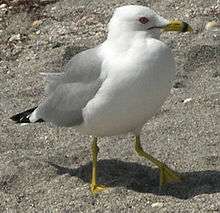
Order: Charadriiformes Family: Laridae
Laridae is a family of medium to large seabirds and includes gulls, terns, kittiwakes and skimmers. They are typically grey or white, often with black markings on the head or wings. They have stout, longish bills, and webbed feet.
- Black-legged kittiwake, Rissa tridactyla LC
- Red-legged kittiwake, Rissa brevirostris VU
- Ivory gull, Pagophila eburnea NT
- Sabine's gull, Xema sabini LC
- Bonaparte's gull, Chroicocephalus philadelphia LC
- Black-headed gull, Chroicocephalus ridibundus LC
- Little gull, Hydrocoloeus minutus LC
- Ross's gull, Rhodostethia rosea LC
- Laughing gull, Leucophaeus atricilla LC
- Franklin's gull, Leucophaeus pipixcan LC
- Heermann's gull, Larus heermanni NT
- Mew gull, Larus canus LC
- Ring-billed gull, Larus delawarensis LC
- Western gull, Larus occidentalis LC
- California gull, Larus californicus LC
- Herring gull, Larus (argentatus) smithsonianus (L. argentatus: )
- Yellow-legged gull, Larus cachinnans (C) LC
- Thayer's gull, Larus thayeri LC
- Iceland gull, Larus glaucoides (without L. thayeri: LC)
- Lesser black-backed gull, Larus fuscus LC
- Slaty-backed gull, Larus schistisagus LC
- Glaucous-winged gull, Larus glaucescens LC
- Glaucous gull, Larus hyperboreus LC
- Great black-backed gull, Larus marinus LC
- Gull-billed tern, Gelochelidon nilotica LC
- Caspian tern, Hydroprogne caspia LC
- Royal tern, Thalasseus maximus LC
- Elegant tern, Thalasseus elegans NT
- Sandwich tern, Sterna sandvicensis LC
- Roseate tern, Sterna dougallii LC
- Common tern, Sterna hirundo LC
- Arctic tern, Sterna paradisaea LC
- Forster's tern, Sterna forsteri LC
- Least tern, Sternula antillarum LC
- Aleutian tern, Onychoprion aleuticus LC
- Bridled tern, Onychoprion anaethetus LC
- Sooty tern, Onychoprion fuscatus LC
- Large-billed tern, Phaetusa simplex (A) LC
- White-winged tern, Chlidonias leucopterus (C) LC
- Black tern, Chlidonias niger LC
- Black skimmer, Rynchops niger LC
Skuas
Order: Charadriiformes Family: Stercorariidae
Skuas are, in general, medium to large birds, typically with grey or brown plumage, often with white markings on the wings. They have longish bills with hooked tips and webbed feet with sharp claws. They look like large dark gulls, but have a fleshy cere above the upper mandible. They are strong, acrobatic fliers.
- Great skua, Stercorarius skua LC
- South polar skua, Stercorarius maccormicki LC
- Pomarine jaeger, Stercorarius pomarinus LC
- Parasitic jaeger, Stercorarius parasiticus LC
- Long-tailed jaeger, Stercorarius longicaudus LC
Auks, murres and puffins
Order: Charadriiformes Family: Alcidae
Alcids are superficially similar to penguins due to their black-and-white colours, their upright posture and some of their habits, however they are only distantly related to the penguins and are able to fly. Auks live on the open sea, only deliberately coming ashore to nest.
- Dovekie, Alle alle LC
- Common murre, Uria aalge LC
- Thick-billed murre, Uria lomvia LC
- Razorbill, Alca torda LC
- Great auk, Pinguinus impennis (E) EX
- Black guillemot, Cepphus grylle LC
- Pigeon guillemot, Cepphus columba LC
- Long-billed murrelet, Brachyramphus perdix NT
- Marbled murrelet, Brachyramphus marmoratus EN
- Kittlitz's murrelet, Brachyramphus brevirostris CR
- Scripps's murrelet, Synthliboramphus scrippsi (S. hypoleucus: VU)
- Guadalupe murrelet, Synthliboramphus hypoleucus VU
- Craveri's murrelet, Synthliboramphus craveri VU
- Ancient murrelet, Synthliboramphus antiquus LC
- Cassin's auklet, Ptychoramphus aleuticus LC
- Parakeet auklet, Aethia psittacula LC
- Least auklet, Aethia pusilla LC
- Crested auklet, Aethia cristatella LC
- Rhinoceros auklet, Cerorhinca monocerata LC
- Atlantic puffin, Fratercula arctica LC
- Horned puffin, Fratercula corniculata LC
- Tufted puffin, Fratercula cirrhata LC
Pigeons and doves
Order: Columbiformes Family: Columbidae
Pigeons and doves are stout-bodied birds with short necks and short slender bills with a fleshy cere.
- Rock dove, Columba livia (I) LC
- Band-tailed pigeon, Patagioenas fasciata LC
- Oriental turtle dove, Streptopelia orientalis (C) LC
- European turtle dove, Streptopelia turtur (A) LC
- White-winged dove, Zenaida asiatica LC
- Zenaida dove, Zenaida aurita (A) LC
- Mourning dove, Zenaida macroura LC
- Passenger pigeon, Ectopistes migratorius (E) EX
- Inca dove, Columbina inca LC
- Common ground dove, Columbina passerina LC
Cuckoos, roadrunners and anis

Order: Cuculiformes Family: Cuculidae
The family Cuculidae includes cuckoos, roadrunners and anis. These birds are of variable size with slender bodies, long tails and strong legs.
- Black-billed cuckoo, Coccyzus erythropthalmus LC
- Yellow-billed cuckoo, Coccyzus americanus LC
Barn owls
Order: Strigiformes Family: Tytonidae
Barn owls are medium to large owls with large heads and characteristic heart-shaped faces. They have long, strong legs with powerful talons.
- Barn owl, Tyto alba LC
Typical owls
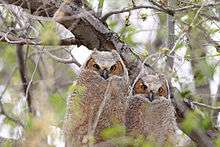
Order: Strigiformes Family: Strigidae
Typical owls are small to large solitary nocturnal birds of prey. They have large forward-facing eyes and ears, a hawk-like beak and a conspicuous circle of feathers around each eye called a facial disk.
- Flammulated owl, Psiloscops flammeolus LC
- Western screech owl, Megascops kennicottii LC
- Eastern screech owl, Megascops asio LC
- Great horned owl, Bubo virginianus LC
- Snowy owl, Bubo scandiacus LC
- Northern hawk-owl, Surnia ulula LC
- Mountain pygmy owl, Glaucidium gnoma LC
- Burrowing owl, Athene cunicularia LC
- Spotted owl, Strix occidentalis NT
- Barred owl, Strix varia LC
- Great grey owl, Strix nebulosa LC
- Long-eared owl, Asio otus LC
- Short-eared owl, Asio flammeus LC
- Boreal owl, Aegolius funereus LC
- Northern saw-whet owl, Aegolius acadicus LC
Nightjars
Order: Caprimulgiformes Family: Caprimulgidae
Nightjars are medium-sized nocturnal birds that usually nest on the ground. They have long wings, short legs and very short bills. Most have small feet, of little use for walking, and long pointed wings. Their soft plumage is cryptically coloured to resemble bark or leaves.
- Lesser nighthawk, Chordeiles acutipennis LC
- Common nighthawk, Chordeiles minor LC
- Common poorwill, Phalaenoptilus nuttallii LC
- Chuck-will's-widow, Antrostomus carolinensis LC
- Eastern whip-poor-will, Antrostomus vociferus LC
Swifts
Order: Apodiformes Family: Apodidae
The swifts are small birds which spend the majority of their lives flying. These birds have very short legs and never settle voluntarily on the ground, perching instead only on vertical surfaces. Many swifts have long swept-back wings which resemble a crescent or boomerang.
- Black swift, Cypseloides niger LC
- Chimney swift, Chaetura pelagica NT
- Vaux's swift, Chaetura vauxi LC
- White-throated needletail Hirundapus caudacutus (A) LC
- White-throated swift, Aeronautes saxatalis LC
Hummingbirds

Order: Apodiformes Family: Trochilidae
Hummingbirds are small birds capable of hovering in mid-air due to the rapid flapping of their wings. They are the only birds that can fly backwards.
- Broad-billed hummingbird, Cynanthus latirostris LC
- Ruby-throated hummingbird, Archilochus colubris LC
- Black-chinned hummingbird, Archilochus alexandri LC
- Anna's hummingbird, Calypte anna LC
- Costa's hummingbird, Calypte costae LC
- Calliope hummingbird, Selasphorus calliope LC
- Broad-tailed hummingbird, Selasphorus platycercus LC
- Rufous hummingbird, Selasphorus rufus LC
Kingfishers
Order: Coraciiformes Family: Alcedinidae
Kingfishers are medium-sized birds with large heads, long, pointed bills, short legs, and stubby tails.
- Belted kingfisher, Megaceryle alcyon LC
Woodpeckers, sapsuckers and flickers
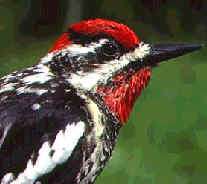
Order: Piciformes Family: Picidae
Woodpeckers are small to medium-sized birds with chisel-like beaks, short legs, stiff tails and long tongues used for capturing insects. Some species have feet with two toes pointing forward and two backward, while several species have only three toes. Many woodpeckers have the habit of tapping noisily on tree trunks with their beaks.
- Lewis's woodpecker, Melanerpes lewis LC
- Red-headed woodpecker, Melanerpes erythrocephalus NT
- Red-bellied woodpecker, Melanerpes carolinus LC
- Williamson's sapsucker, Sphyrapicus thyroideus LC
- Yellow-bellied sapsucker, Sphyrapicus varius LC
- Red-naped sapsucker, Sphyrapicus nuchalis LC
- Red-breasted sapsucker, Sphyrapicus ruber LC
- Downy woodpecker, Picoides pubescens LC
- Hairy woodpecker, Picoides villosus LC
- White-headed woodpecker, Picoides albolarvatus LC
- American three-toed woodpecker, Picoides dorsalis LC
- Black-backed woodpecker, Picoides arcticus LC
- Northern flicker, Colaptes auratus LC
- Pileated woodpecker, Dryocopus pileatus LC
Tyrant flycatchers
Order: Passeriformes Family: Tyrannidae
Tyrant flycatchers are Passerine birds which occur throughout North and South America. They superficially resemble the Old World flycatchers, but are more robust and have stronger bills. They do not have the sophisticated vocal capabilities of the songbirds. Most, but not all, are rather plain. As the name implies, most are insectivorous.
- Northern beardless-tyrannulet, Camptostoma imberbe LC
- Greenish elaenia, Myiopagis viridicata (A) LC
- White-crested elaenia, Elaenia albiceps (A) LC
- Tufted flycatcher, Mitrephanes phaeocercus (A) LC
- Olive-sided flycatcher, Contopus cooperi NT
- Western wood-pewee, Contopus sordidulus LC
- Eastern wood-pewee, Contopus virens LC
- Yellow-bellied flycatcher, Empidonax flaviventris LC
- Acadian flycatcher, Empidonax virescens LC
- Alder flycatcher, Empidonax alnorum LC
- Willow flycatcher, Empidonax traillii LC
- Least flycatcher, Empidonax minimus LC
- Hammond's flycatcher, Empidonax hammondii LC
- Grey flycatcher, Empidonax wrightii LC
- Dusky flycatcher, Empidonax oberholseri LC
- Pacific-slope flycatcher, Empidonax difficilis LC
- Cordilleran flycatcher, Empidonax occidentalis LC
- Black phoebe, Sayornis nigricans LC
- Eastern phoebe, Sayornis phoebe LC
- Say's phoebe, Sayornis saya LC
- Vermilion flycatcher, Pyrocephalus rubinus LC
- Ash-throated flycatcher, Myiarchus cinerascens LC
- Great crested flycatcher, Myiarchus crinitus LC
- Brown-crested flycatcher, Myiarchus tyrannulus LC
- Sulphur-bellied flycatcher, Myiodynastes luteiventris LC
- Variegated flycatcher, Empidonomus varius (A) LC
- Tropical kingbird, Tyrannus melancholicus LC
- Cassin's kingbird, Tyrannus vociferans LC
- Thick-billed kingbird, Tyrannus crassirostris LC
- Western kingbird, Tyrannus verticalis LC
- Eastern kingbird, Tyrannus tyrannus LC
- Grey kingbird, Tyrannus dominicensis LC
- Loggerhead kingbird, Tyrannus caudifasciatus (A) LC
- Scissor-tailed flycatcher, Tyrannus forficatus LC
- Fork-tailed flycatcher, Tyrannus savana LC
Shrikes
.jpg)
Order: Passeriformes Family: Laniidae
Shrikes are passerine birds known for their habit of catching other birds and small animals and impaling the uneaten portions of their bodies on thorns. A typical shrike's beak is hooked.
- Loggerhead shrike, Lanius ludovicianus LC
- Northern shrike, Lanius excubitor LC
Vireos
Order: Passeriformes Family: Vireonidae
The vireos are a group of small to medium-sized passerine birds restricted to the New World. They are typically greenish in colour and resemble wood warblers, apart from their heavier bills.
- White-eyed vireo, Vireo griseus LC
- Bell's vireo, Vireo bellii NT
- Black-capped vireo, Vireo atricapilla VU
- Yellow-throated vireo, Vireo flavifrons LC
- Plumbeous vireo, Vireo plumbeus LC
- Cassin's vireo, Vireo cassinii LC
- Blue-headed vireo, Vireo solitarius LC
- Hutton's vireo, Vireo huttoni LC
- Warbling vireo, Vireo gilvus LC
- Philadelphia vireo, Vireo philadelphicus LC
- Red-eyed vireo, Vireo olivaceus LC
Jays, crows, magpies and ravens
Order: Passeriformes Family: Corvidae
The family Corvidae includes crows, ravens, jays, choughs, magpies, treepies, nutcrackers and ground jays. Corvids are above average in size among the Passeriformes, and some of the larger species show high levels of intelligence.
- Canada jay, Perisoreus canadensis LC
- Steller's jay, Cyanocitta stelleri LC
- Blue jay, Cyanocitta cristata LC
- California scrub jay, Aphelocoma californica LC
- Clark's nutcracker, Nucifraga columbiana LC
- Black-billed magpie, Pica hudsonia LC
- Eurasian jackdaw, Corvus monedula (C) LC
- American crow, Corvus brachyrhynchos LC
- Northwestern crow, Corvus caurinus LC
- Fish crow, Corvus ossifragus LC
- Common raven, Corvus corax LC
Larks
Order: Passeriformes Family: Alaudidae
Larks are small terrestrial birds with often extravagant songs and display flights. Most larks are fairly dull in appearance. They feed on insects and seeds.
- Eurasian skylark, Alauda arvensis LC
- Horned lark, Eremophila alpestris LC
Swallows and martins
Order: Passeriformes Family: Hirundinidae
The family Hirundinidae is adapted to aerial feeding. They have a slender streamlined body, long pointed wings and a short bill with a wide gape. The feet are adapted to perching rather than walking, and the front toes are partially joined at the base.
- Purple martin, Progne subis LC
- Tree swallow, Tachycineta bicolor LC
- Violet-green swallow, Tachycineta thalassina LC
- Northern rough-winged swallow, Stelgidopteryx serripennis LC
- Bank swallow, Riparia riparia LC
- Cliff swallow, Petrochelidon pyrrhonota LC
- Cave swallow, Petrochelidon fulva LC
- Barn swallow, Hirundo rustica LC
Chickadees and titmice
Order: Passeriformes Family: Paridae
The Paridae are mainly small stocky woodland species with short stout bills. Some have crests. They are adaptable birds, with a mixed diet including seeds and insects.
- Carolina chickadee, Poecile carolinensis LC
- Black-capped chickadee, Poecile atricapillus LC
- Mountain chickadee, Poecile gambeli LC
- Chestnut-backed chickadee, Poecile rufescens LC
- Boreal chickadee, Poecile hudsonicus LC
- Grey-headed chickadee, Poecile cinctus LC
- Tufted titmouse, Baeolophus bicolor LC
Bushtits
Order: Passeriformes Family: Aegithalidae
The long-tailed tits are a family of small passerine birds. Their plumage is typically dull grey or brown in colour. There is only one North American representative of this primarily Palearctic family.
- Bushtit, Psaltriparus minimus LC
Nuthatches
Order: Passeriformes Family: Sittidae
Nuthatches are small woodland birds. They have the unusual ability to climb down trees head first, unlike other birds, which can only go upwards. Nuthatches have large heads, short tails and powerful bills and feet.
- Red-breasted nuthatch, Sitta canadensis LC
- White-breasted nuthatch, Sitta carolinensis LC
- Pygmy nuthatch, Sitta pygmaea LC
Treecreepers
Order: Passeriformes Family: Certhiidae
Treecreepers are small woodland birds, brown above and white below. They have thin, down-pointed, curved bills, which they use to extricate insects from bark. They have stiff tail feathers, like woodpeckers, which they use to support themselves vertically on trees.
- Brown creeper, Certhia americana LC
Wrens
Order: Passeriformes Family: Troglodytidae
Wrens are small and inconspicuous birds, except for their loud songs. They have short wings and thin down-turned bills. Several species often hold their tails upright. All are insectivorous.
- Rock wren, Salpinctes obsoletus LC
- Canyon wren, Catherpes mexicanus LC
- Carolina wren, Thryothorus ludovicianus LC
- Bewick's wren, Thryomanes bewickii LC
- House wren, Troglodytes aedon LC
- Winter wren, Troglodytes hiemalis LC
- Pacific wren, Troglodytes pacificus (T. troglodytes: LC)
- Sedge wren, Cistothorus platensis LC
- Marsh wren, Cistothorus palustris LC
Gnatcatchers
Order: Passeriformes Family: Polioptilidae
These dainty birds resemble Old World warblers in their structure and habits, moving restlessly through the foliage seeking insects. The gnatcatchers are mainly soft bluish grey in colour and have the typical insectivore's long, sharp bill. Many species have distinctive black head patterns (especially males) and long, regularly cocked, black-and-white tails.
- Blue-grey gnatcatcher, Polioptila caerulea LC
Dippers
Order: Passeriformes Family: Cinclidae
Dippers are named for their bobbing or dipping movements. They are unique among passerines for their ability to dive and swim underwater.
- American dipper, Cinclus mexicanus LC
Kinglets
Order: Passeriformes Family: Regulidae
The kinglets are a small family of birds which resemble the titmice. They are very small, insectivorous birds in the genus Regulus. The adults have coloured crowns, giving rise to their name.
- Golden-crowned kinglet, Regulus satrapa LC
- Ruby-crowned kinglet, Regulus calendula LC
Leaf warblers
Order: Passeriformes Family: Phylloscopidae
- Arctic warbler, Phylloscopus borealis LC
Reed warblers
Order: Passeriformes Family: Acrocephalidae
- Sedge warbler, Acrocephalus schoenobaenus (A) LC
Old World flycatchers
Order: Passeriformes Family: Muscicapidae
This a large family of small passerine birds restricted to the Old World. Species below only occurs in Canada as vagrants. The appearance of these birds is highly varied, but they mostly have weak songs and harsh calls.
- Northern wheatear, Oenanthe oenanthe LC
Thrushes
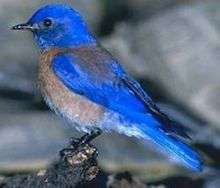
Order: Passeriformes Family: Turdidae
The thrushes are a group of passerine birds that occur mainly but not exclusively in the Old World. They are plump, soft plumaged, small to medium-sized insectivores or sometimes omnivores, often feeding on the ground. Many have attractive songs.
- Eastern bluebird, Sialia sialis LC
- Western bluebird, Sialia mexicana LC
- Mountain bluebird, Sialia currucoides LC
- Townsend's solitaire, Myadestes townsendi LC
- Veery, Catharus fuscescens LC
- Grey-cheeked thrush, Catharus minimus LC
- Bicknell's thrush, Catharus bicknelli VU
- Swainson's thrush, Catharus ustulatus LC
- Hermit thrush, Catharus guttatus LC
- Wood thrush, Hylocichla mustelina LC
- Eurasian blackbird, Turdus merula (A) LC
- Eyebrowed thrush, Turdus obscurus LC
- Dusky thrush, Turdus naumanni (C) LC
- Fieldfare, Turdus pilaris (C) LC
- Redwing, Turdus iliacus (C) LC
- American robin, Turdus migratorius LC
- Varied thrush, Ixoreus naevius LC
Mockingbirds and thrashers
Order: Passeriformes Family: Mimidae
The mimids are a family of passerine birds which includes thrashers, mockingbirds, tremblers, and the New World catbirds. These birds are notable for their vocalization, especially their remarkable ability to mimic a wide variety of birds and other sounds heard outdoors. The species tend towards dull greys and browns in their appearance.
- Grey catbird, Dumetella carolinensis LC
- Northern mockingbird, Mimus polyglottos LC
- Sage thrasher, Oreoscoptes montanus LC
- Brown thrasher, Toxostoma rufum LC
- Long-billed thrasher, Toxostoma longirostre LC
- Bendire's thrasher, Toxostoma bendirei VU
- Curve-billed thrasher, Toxostoma curvirostre LC
Starlings and mynas

Order: Passeriformes Family: Sturnidae
Starlings and mynas are small to medium-sized Old World passerine birds with strong feet. Their flight is strong and direct and most are very gregarious. Their preferred habitat is fairly open country, and they eat insects and fruit. The plumage of several species is dark with a metallic sheen.
- European starling, Sturnus vulgaris (I) LC
- Crested myna, Acridotheres cristatellus (I) LC
Wagtails and pipits
Order: Passeriformes Family: Motacillidae
Motacillidae is a family of small passerine birds with medium to long tails. They include the wagtails, longclaws, and pipits. They are slender, ground feeding insectivores of open country. There are 54 species worldwide and 11 North American species.
- Buff-bellied pipit, Anthus rubescens LC
- Sprague's pipit, Anthus spragueii VU
Waxwings
Order: Passeriformes Family: Bombycillidae
The waxwings are a group of birds with soft silky plumage and unique red tips to some of the wing feathers. In the Bohemian and cedar waxwings, these tips look like sealing wax and give the group its name. These are arboreal birds of northern forests. They live on insects in the summer and berries in winter.
- Bohemian waxwing, Bombycilla garrulus LC
- Cedar waxwing, Bombycilla cedrorum LC
Longspurs
Order: Passeriformes Family: Calcariidae
The Calcariidae are a group of passerine birds which have been traditionally grouped with the Emberizeridae (New World sparrows), but differ in a number of respects and are usually found in open grassy areas.
- McCown's longspur, Rhynchophanes mccownii LC
- Lapland longspur, Calcarius lapponicus LC
- Smith's longspur, Calcarius pictus LC
- Chestnut-collared longspur, Calcarius ornatus NT
- Snow bunting, Plectrophenax nivalis LC
Wood warblers
Order: Passeriformes Family: Parulidae

The wood warblers are a group of small, often colourful passerine birds restricted to the New World. Most are arboreal, but some are more terrestrial. Most members of this family are insectivores. In August 2011, the North American Committee of the AOU changed their classification of many of the wood warblers. Since this list is based on the AOU classification, changes to scientific names are updated here. Since many other taxonomic committees have yet to rule on these changes (including the South American Committee of the AOU) or have ruled in other ways, species pages remain with their original scientific names until more of a consensus is achieved.
- Blue-winged warbler, Vermivora cyanoptera LC
- Golden-winged warbler, Vermivora chrysoptera NT
- Tennessee warbler, Oreothlypis peregrina LC
- Orange-crowned warbler, Oreothlypis celata LC
- Nashville warbler, Oreothlypis ruficapilla LC
- Hooded warbler, Setophaga citrina LC
- Northern parula, Setophaga americana LC
- Yellow warbler, Setophaga petechia LC
- Chestnut-sided warbler, Setophaga pensylvanica LC
- Magnolia warbler, Setophaga magnolia LC
- Cape May warbler, Setophaga tigrina LC
- Black-throated blue warbler, Setophaga caerulescens LC
- Yellow-rumped warbler, Setophaga coronata LC
- Black-throated grey warbler, Setophaga nigrescens LC
- Black-throated green warbler, Setophaga virens LC
- Townsend's warbler, Setophaga townsendi LC
- Hermit warbler, Setophaga occidentalis LC
- Blackburnian warbler, Setophaga fusca LC
- Yellow-throated warbler, Setophaga dominica LC
- Pine warbler, Setophaga pinus LC
- Kirtland's warbler, Setophaga kirtlandii NT
- Prairie warbler, Setophaga discolor LC
- Palm warbler, Setophaga palmarum LC
- Bay-breasted warbler, Setophaga castanea LC
- Blackpoll warbler, Setophaga striata LC
- Cerulean warbler, Setophaga cerulea VU
- American redstart, Setophaga ruticilla LC
- Black-and-white warbler, Mniotilta varia LC
- Prothonotary warbler, Protonotaria citrea LC
- Worm-eating warbler, Helmitheros vermivorus LC
- Ovenbird, Seiurus aurocapilla LC
- Northern waterthrush, Parkesia noveboracensis LC
- Louisiana waterthrush, Parkesia motacilla LC
- Connecticut warbler, Oporornis agilis LC
- Mourning warbler, Geothlypis philadelphia LC
- MacGillivray's warbler, Geothlypis tolmiei LC
- Kentucky warbler, Geothlypis formosa LC
- Common yellowthroat, Geothlypis trichas LC
- Wilson's warbler, Cardellina pusilla LC
- Canada warbler, Cardellina canadensis LC
- Yellow-breasted chat, Icteria virens LC
American sparrows, towhees and juncos
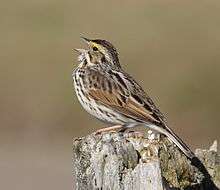
Order: Passeriformes Family: Emberizidae
Emberizidae is a large family of passerine birds. They are seed-eating birds with distinctively shaped bills. In Europe, most species are called buntings. In North America, most of the species in this family are known as sparrows, but these birds are not closely related to the Old World sparrows which are in the family Passeridae. Many emberizid species have distinctive head patterns.
- Green-tailed towhee, Pipilo chlorurus LC
- Spotted towhee, Pipilo maculatus LC
- Eastern towhee, Pipilo erythrophthalmus LC
- American tree sparrow, Spizelloides arborea LC
- Chipping sparrow, Spizella passerina LC
- Clay-coloured sparrow, Spizella pallida LC
- Brewer's sparrow, Spizella breweri LC
- Field sparrow, Spizella pusilla LC
- Vesper sparrow, Pooecetes gramineus LC
- Lark sparrow, Chondestes grammacus LC
- Black-throated sparrow, Amphispiza bilineata LC
- Sagebrush sparrow, Artemisiospiza nevadensis (A. belli: LC)
- Lark bunting, Calamospiza melanocorys LC
- Savannah sparrow, Passerculus sandwichensis LC
- Grasshopper sparrow, Ammodramus savannarum LC
- Baird's sparrow, Ammodramus bairdii LC
- Henslow's sparrow, Ammodramus henslowii NT
- Le Conte's sparrow, Ammodramus leconteii LC
- Nelson's sparrow, Ammodramus nelsoni LC
- Fox sparrow, Passerella iliaca LC
- Song sparrow, Melospiza melodia LC
- Lincoln's sparrow, Melospiza lincolnii LC
- Swamp sparrow, Melospiza georgiana LC
- White-throated sparrow, Zonotrichia albicollis LC
- Harris's sparrow, Zonotrichia querula LC
- White-crowned sparrow, Zonotrichia leucophrys LC
- Golden-crowned sparrow, Zonotrichia atricapilla LC
- Dark-eyed junco, Junco hyemalis LC
- Rustic bunting, Emberiza rustica LC
Cardinals, grosbeaks and allies
Order: Passeriformes Family: Cardinalidae
The cardinals are a family of robust, seed-eating birds with strong bills. They are typically associated with open woodlands. The sexes usually have distinct plumages.
- Summer tanager, Piranga rubra LC
- Scarlet tanager, Piranga olivacea LC
- Western tanager, Piranga ludoviciana LC
- Northern cardinal, Cardinalis cardinalis LC
- Rose-breasted grosbeak, Pheucticus ludovicianus LC
- Black-headed grosbeak, Pheucticus melanocephalus LC
- Blue grosbeak, Passerina caerulea LC
- Lazuli bunting, Passerina amoena LC
- Indigo bunting, Passerina cyanea LC
- Painted bunting, Passerina ciris NT
- Dickcissel, Spiza americana LC
Icterids, meadowlarks, cowbirds, grackles and orioles
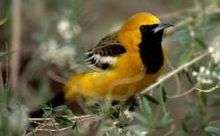
Order: Passeriformes Family: Icteridae
The icterids are a group of small to medium-sized, often colourful passerine birds restricted to the New World and include the grackles, New World blackbirds and New World orioles. Most species have black as a predominant plumage colour, often enlivened by yellow, orange or red.
- Bobolink, Dolichonyx oryzivorus LC
- Red-winged blackbird, Agelaius phoeniceus LC
- Eastern meadowlark, Sturnella magna LC
- Western meadowlark, Sturnella neglecta LC
- Yellow-headed blackbird, Xanthocephalus xanthocephalus LC
- Rusty blackbird, Euphagus carolinus VU
- Brewer's blackbird, Euphagus cyanocephalus LC
- Common grackle, Quiscalus quiscula LC
- Brown-headed cowbird, Molothrus ater LC
- Orchard oriole, Icterus spurius LC
- Bullock's oriole, Icterus bullockii LC
- Baltimore oriole, Icterus galbula LC
- Scott's oriole, Icterus parisorum LC
Finches
Order: Passeriformes Family: Fringillidae
Finches are seed-eating passerine birds, that are small to moderately large and have a strong beak, usually conical and in some species very large. All have twelve tail feathers and nine primaries. These birds have a bouncing flight with alternating bouts of flapping and gliding on closed wings, and most sing well.
- Grey-crowned rosy finch, Leucosticte tephrocotis LC
- Pine grosbeak, Pinicola enucleator LC
- Purple finch, Haemorhous purpureus LC
- Cassin's finch, Haemorhous cassinii NT
- House finch, Haemorhous mexicanus LC
- Red crossbill, Loxia curvirostra LC
- White-winged crossbill, Loxia leucoptera LC
- Common redpoll, Acanthis flammea LC
- Hoary redpoll, Acanthis hornemanni
- Pine siskin, Spinus pinus LC
- American goldfinch, Spinus tristis LC
- Evening grosbeak, Coccothraustes vespertinus LC
Old World sparrows
Order: Passeriformes Family: Passeridae
Old World sparrows are small passerine birds. In general, sparrows tend to be small plump brownish or greyish birds with short tails and short powerful beaks. Sparrows are seed eaters, but they also consume small insects.
- House sparrow, Passer domesticus (I) LC
See also
- List of birds
- Lists of birds by region
- List of North American birds
- List of mammals of Canada
- List of amphibians of Canada
- List of reptiles of Canada
References
- ↑ "Historical perspective". U.S. Geological Survey. Retrieved April 21, 2008.
- ↑ "The IUCN Red List of Threatened Species". International Union for Conservation of Nature and Natural Resources. Retrieved 5 March 2014.
- Check-list of North American Birds (7th ed.). Washington, D.C.: American Ornithologists' Union. 1998. ISBN 1-891276-00-X. Retrieved February 26, 2008.
- "ABA checklist". American Birding Association. Retrieved 24 August 2016.
- Collinson, Martin (June 2006). "Splitting headaches? Recent taxonomic changes affecting the British and Western Palaearctic lists". British Birds. 99: 306–23.

